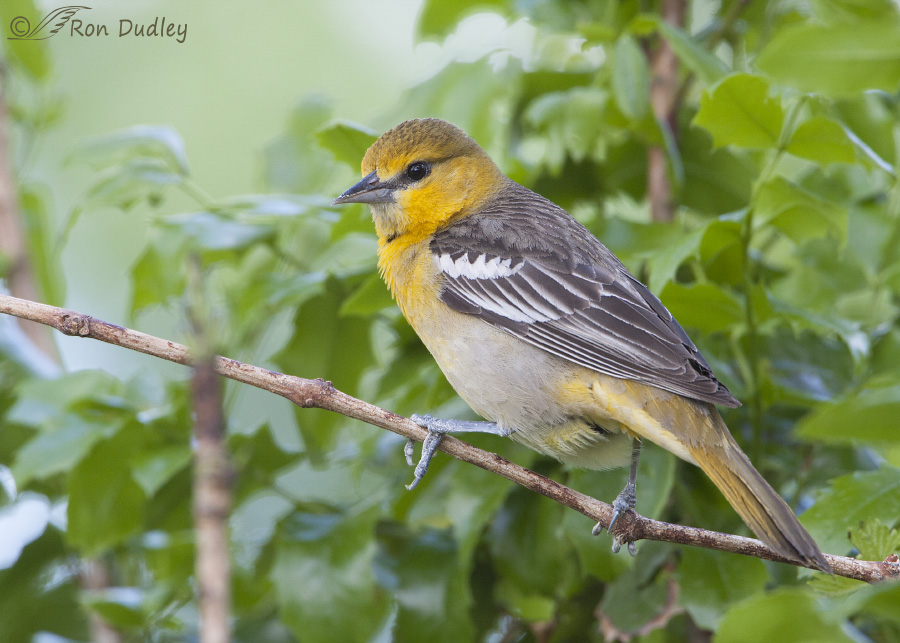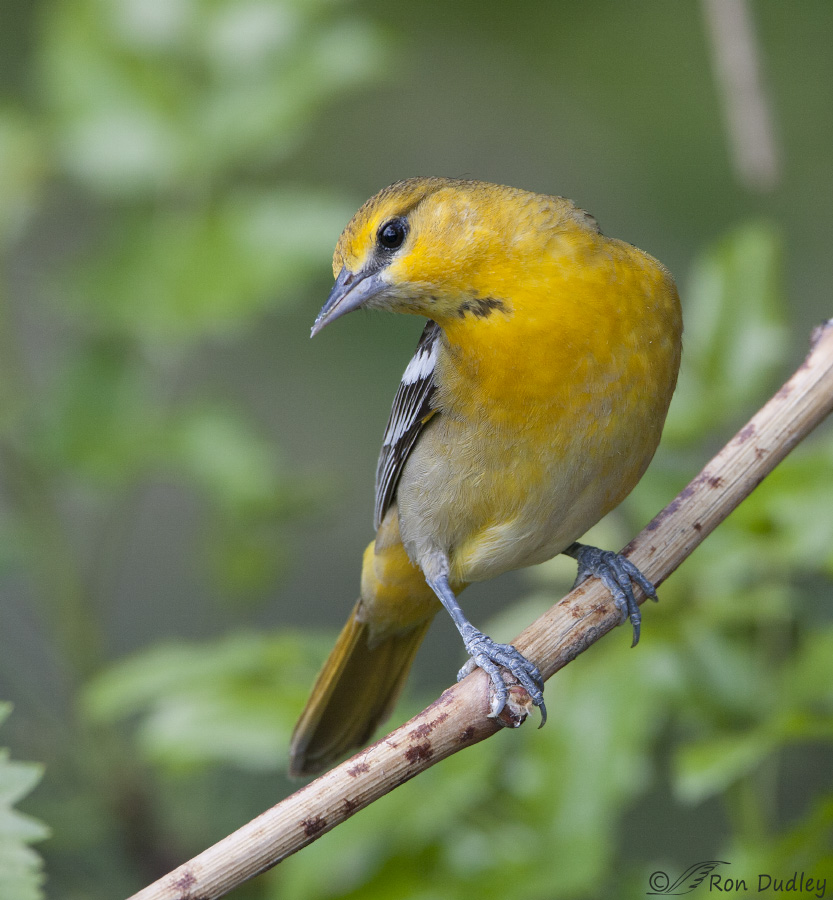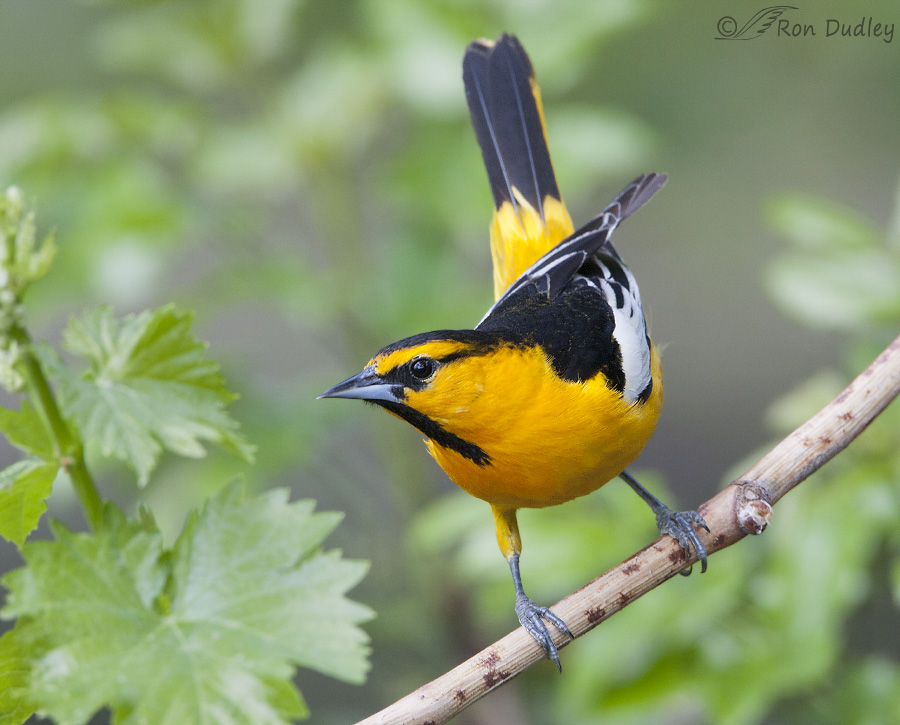These images were taken very early in my bird photography career. In late May of 2008 I’d only had my 500mm f/4 lens for about a year and I was still learning how to use it to its potential. So I’d often set it up on a tripod in my back yard and photograph yard birds for practice (believe me, I needed it). Mostly I was shooting common species like House Finches, House Sparrows, American Goldfinches, American Robins and Mourning Doves but occasionally something “special” would show up.
On this day, 5/24/08, it was three Bullock’s Orioles.
1/250, f/8, ISO 500, Canon 40D, Canon EF 500mm f/4L IS II USM + 1.4 tc
I believe this one was a juvenile (first year) female. It was midafternoon and all three birds were hanging out in my densely shaded grapevines so I had very little shutter speed and many of my images were soft. Another problem was getting clear, unobscured looks at them but occasionally they’d land on a couple of bare vines that gave me a chance at relatively clean shots.
1/320, f/8, ISO 500, Canon 40D, Canon EF 500mm f/4L IS II USM + 1.4 tc
I believe this bird to be a juvenile male but the black spot on the throat confuses me a little. It’s my understanding that females should have no black there at all and by this age young males should have a completely black throat. So it would be appreciated if someone can enlighten me on the age and sex of these two birds.
It’s even possible that these first two birds are the same individual. I just don’t remember…
1/320, f/8, ISO 500, Canon 40D, Canon EF 500mm f/4L IS II USM + 1.4 tc
And this is the spectacular adult male. I was quite close to this bird so I had limited composition options, thus the squarish crop. It would have been nice to have had more depth of field to get the tail sharp but at this shutter speed I was lucky that anything was sharp on this twitchy bird.
These images were taken so long ago that I don’t recall many of the circumstances but it’s entirely possible that these birds were in my yard after nectar in my hummingbird feeder. For that reason I haven’t included my usual “not baited, set up or called in” with my image techs. In later years I deliberately put nectar out specifically for orioles but when they first started showing up they were an unexpected and delightful surprise.
I very rarely post yard birds on my blog but when I ran across these images last night during a stroll down memory lane I decided to make an exception. I hope readers enjoy them as much as I do.
Ron





Beautiful shots Ron. They are beautiful birds.
That last pic of the male is stunning. Thanks for sharing!
I have yet to see/photograph an Oriole, any sub-species. The 3rd is my favourite here.
I hope you see one (or more) some day, Elmer. They’re a feast for the eyes.
These are all beauties Ron, a stunning species too. Backyard birds can be quite relaxing to photograph, just pull up the lawn chair and wait for the birds to arrive. The image quality of these photos is exquisite in spite of the fact that you were at the start of your avian photography adventure. Thanks for posting these. Gary.
Thanks, Gary. Seeing your name always brings back fond memories of NPN. And of your welcome presence there.
That last shot is quite stunning! Thank you for this stroll down memory lane. I guess it’s true about the adventure you find right out your door. You have a very interesting yard! I’d love to see more of your backyard “jungle.”
As far as the dog is concerned, perhaps your neighbor can bring him inside while you’re photographing, or you could toss some treats to the dog so that he looks forward to you being out in the yard. The dogs next door used to go crazy any time I’m out in the yard, so I asked my neighbor about tossing treats. I’ve linked my voice with the treats and now just my calling out to them settles them down, although I do a bit of intermittent treat reinforcement now and again. Blue Buffalo and Zukes have small training treats that work well — especially the Zukes salmon treats (stinky, yet effective — I use them at the animal shelter when I’m training dogs).
Whoops! Didn’t mean to hijack and turn it into a dog training post. Sorry about that!
Marty, Guess I’ll try the dog treats. Nothing else seems to work. Thanks for the idea.
Just double check to be sure the dog doesn’t have any food allergies.
LOVE your yard birds. And the evidence of your tenacity and determination. Doing anything well requires pratice, pratice, practice. And a smidgeon of luck.
Usually more than just a smidgeon for me, EC. Thank you.
Spectacular photos with such beautifully colored birds. The male’s colors are outstanding and I like the pose as well. Thanks for sharing.
Thanks very much, Alice.
These are so lovely! I know you are hyper-critical of your own work, but I think they are lovely and the middle and last images are just stunning. I also know that being hyper-critical of your work has driven you to the level of excellence you’ve achieved in your photography, teaching and life, so given that outcome, it’s a really good thing.
Thank you, Sharon. I guess I am sorta critical but I can’t help myself. I think it helps me to strive for improvement.
Beautiful again. I like the pose and the out of focus tail in the last photo. It really brings the center of attention to the eye and the face. I wish I regularly had orioles in my yard.
And I wish I’d had as much luck with birds up north this morning as you did a couple of days ago, April. We’re even…
I wish you had too. It was incredible. I will probably NEVER duplicated the day.
Ooooh–Orioles! Among my most favorite springtime backyard birds. I love the flash of brilliant yellow- or orange-gold when they come to my yard! I have seen the occasional Bullock’s in my fountain in years past but the Hoodeds are more frequent visitors in SoCal (and just as beautiful, I think). I’m still always shocked by the brilliant color of the males, almost neon, truly spectacular. So glad you posted these images because I find them impossible to photograph. Just the slightest movement from inside my sunroom will scare them off, even if they are partaking in grape jelly at the feeder! (And a female Hooded has just landed there for a couple of bites now! Oops … gone!)
“I’m still always shocked by the brilliant color of the males, almost neon”
That’s always been my reaction to the males too, Chris. Those colors are just so brilliant!
I already knew how you felt about baiting and set ups but I did not know what would you say about those shots taken on local gardens where birds are used to people.
With today’s post came the answer because from my point of view the situation is equivalent either those images are taken on a local garden or your back yard.
And as long as you say how you took them, like you did today, I don’t see anything wrong in taking advantage of the situation because definitively you are not baiting or making set ups.
All this talk only to tell you that it is a pity that you don’t show more of your “yard birds” because they are fabulous.
That last shot was breath taking…
Thank you.
Thank you, Jorge. I really don’t have many “special” yard photos of birds because most of the time I was practicing with various techniques and settings to try to get the hang of my new lens. The biggest value to me wasn’t the resulting photos, it was the practice itself.
What a great start to a very, very successful voyage!!! These are beautiful…love the backgrounds. I hope you, nitpicker that you tend to be, really appreciate these wonderful shots….
I certainly do appreciate them, Patty – yard shots or not!
Absolutely love the last one. I can’t wait till they come to our backyard.
Thank you, Judy.
The photos are beautiful, and the male (as you stated) spectacular. I hope you make your exception more often! If a beautiful bird comes to your yard, even in your yard it can be the subject of a beautiful image. Thank you for sharing a bird we don’t often see around here (New England).
Richard, I very rarely shoot in my yard anymore – for a variety of reasons including a neighbor’s dog who barks incessantly when I’m out there, Who knows though – maybe I’ll try again…
Beautiful series Ron!
charlotte
Thanks, Charlotte.
I too am glad you made the exception! Beautiful shots of beautiful birds. Around here, at least they, don’t sit still very long and I mostly see them harassing other birds they don’t like such as a perched eagle a couple of years ago where they ended up pretty blurry! The adult male is magnificent!
The adult male is magnificent! 
Thanks, Judy. I don’t see this species often so it’s a special occasion when they show up in my yard.
Glad you made the exception!!
These are great shots, in my mind at least, they are exceptional! They are all prize winners, but that male shot is terrific!
Thank you, Dick. That male is pretty nifty, isn’t he?